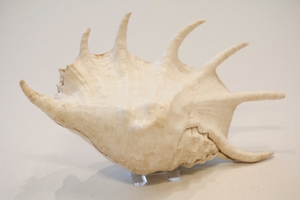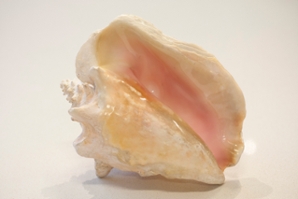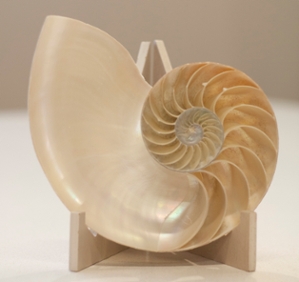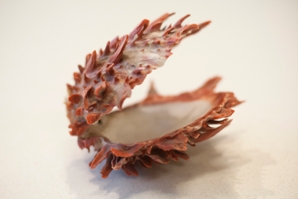Shells at the Frehner Museum
The shells in our collection come from different areas around the globe. Here are few pieces from our museum collection.
- Lambis truncata - Giant Spider Conch
- Lobatus gigas - Queen Conch
- Nautilus macromphalus - Bellybutton Nautilus
- Spondylus spondylosus - Spiny Oyster
Lambis truncata
 Commonly known as the Giant Spider Conch, Lambis truncata is a species of sea snail. It is the largest and heaviest of the spider shells. The shell usually begins as a creamy white color and the lip progressively turns a mauve brown color as it ages. It can be found in the coarse sand and rubble in the shallow waters of the Indian and Pacific Oceans. These shells are sometimes sold for decoration.
Commonly known as the Giant Spider Conch, Lambis truncata is a species of sea snail. It is the largest and heaviest of the spider shells. The shell usually begins as a creamy white color and the lip progressively turns a mauve brown color as it ages. It can be found in the coarse sand and rubble in the shallow waters of the Indian and Pacific Oceans. These shells are sometimes sold for decoration.
Lobatus gigas
 The Queen Conch, also known as Strombus gigas, is a large, edible sea snail. It is native to the northwestern Atlantic Ocean, from Bermuda to Brazil. It is an herbivore and can reach up to 35 cm (13.78 in) in shell length. The adult shell has a wide and thick pink outer opening that younger shells do not have. This shell species is often sold as souvenirs, and was reportedly used for tools by Native Americans and the indigenous people of the Caribbean.
The Queen Conch, also known as Strombus gigas, is a large, edible sea snail. It is native to the northwestern Atlantic Ocean, from Bermuda to Brazil. It is an herbivore and can reach up to 35 cm (13.78 in) in shell length. The adult shell has a wide and thick pink outer opening that younger shells do not have. This shell species is often sold as souvenirs, and was reportedly used for tools by Native Americans and the indigenous people of the Caribbean.
Nautilus macromphalus
 The Bellybutton Nautilus is native to northeastern Australia. This species lives hundreds of meters below the sea surface, but rise at night to shallow waters to feed, sometimes as shallow as 2 meters (6.56 ft). Nautiluses have poor eyesight, so they must rely on their sense of smell and touch to find their food. On average, the shell can grow up to 16 cm (6.3 in) in diameter. A nautilus can live up to 20 years. It is the smallest of its species and is missing the thick area of a shell called the callus, so the coils of the shell are visibly exposed.
The Bellybutton Nautilus is native to northeastern Australia. This species lives hundreds of meters below the sea surface, but rise at night to shallow waters to feed, sometimes as shallow as 2 meters (6.56 ft). Nautiluses have poor eyesight, so they must rely on their sense of smell and touch to find their food. On average, the shell can grow up to 16 cm (6.3 in) in diameter. A nautilus can live up to 20 years. It is the smallest of its species and is missing the thick area of a shell called the callus, so the coils of the shell are visibly exposed.
Spondylus spondylosus
 Commonly known as a spiny oyster, this specimen comes from the Spondylidae family. Spondylus are not related to true oysters ( Ostreidae), but are grouped in the same superfamily as scallops. Spiny oysters cement themselves to rocks, unlike true oysters that use a secretion of bundled filaments to attach to solid surfaces. The two parts of the spiny oyster shell are hinged together with a ball-and-socket type hinge. A Spondylus has a well-developed nervous system and a series of eyes around the edge of its shell. The spiny oyster is sought after by collectors, and is widely used in the commercial sector for jewelry or decoration.
Commonly known as a spiny oyster, this specimen comes from the Spondylidae family. Spondylus are not related to true oysters ( Ostreidae), but are grouped in the same superfamily as scallops. Spiny oysters cement themselves to rocks, unlike true oysters that use a secretion of bundled filaments to attach to solid surfaces. The two parts of the spiny oyster shell are hinged together with a ball-and-socket type hinge. A Spondylus has a well-developed nervous system and a series of eyes around the edge of its shell. The spiny oyster is sought after by collectors, and is widely used in the commercial sector for jewelry or decoration.
This page was updated November 2019.
